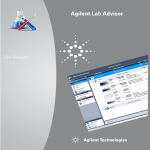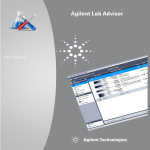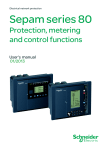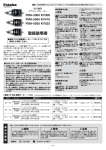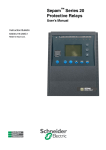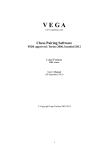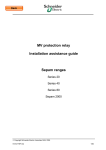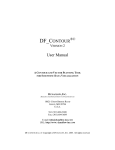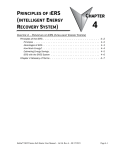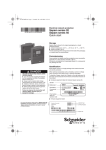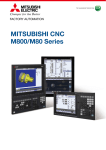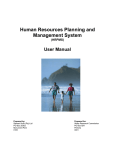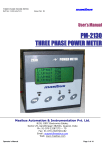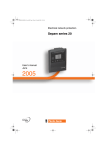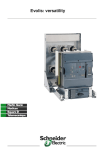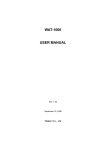Download Sepam 2000 D22 - D32 Merlin Gerin
Transcript
Transformer differential protection Catalogue January 2002 Sepam 2000 D22 - D32 Merlin Gerin Contents Schneider Electric Presentation 2 Selection table 2 Definitions and general parameters 3 Functions and characteristics 4 Differential protection 87T 4 Differential protection 64 REF 5 Measurements 6 Disturbance recording 7 Control and monitoring 8 Operating mode 9 Program logic Sepam 2000 D22 10 Program logic Sepam 2000 D32 12 Modbus communication 14 General characteristics 15 Installation recommendations 16 Determination of current sensors and settings 16 Dimensions and weights Connections 17 Connection schemes Sepam 2000 D22 18 Two-winding transformer 18 Two-winding transformer with earthed neutral point 19 Two-winding transformer with earthing coil 20 Generator-transformer unit 21 Connection schemes Sepam 2000 D32 22 Three-winding transformer 22 Three-winding transformer with 2 earthed neutral points 23 Three-winding auto-transformer 24 Connection schemes 25 Connection of logical inputs/outputs 25 1 Selection table The Sepam 2000 D22 and D32 differential protections are designed to protect a two-ended or a three-ended zone which inckudes a transformer, an auto-transformer or a generator-transformer unit. Advantages MT10593.tif Presentation Sepam 2000 D22 # # # # 5 5 5 # 5 5 5 5 # # # Complete protection against internal transformer faults. Restricted earth fault protection included. Processing of transformer and neutral coil, Buchholz and thermostat data. Simple implementation due to the use of neural networks: simplified sizing of current sensors few settings no matching transformers required. Measurement: primary, secondary currents and phase shifts residual currents differential and through currents memorization of differential and through current at the time of the fault. Test position. Disturbance recording. High level of electromagnetic compatibility (EMC) makes it possible to use digital technology in electrical substations, without the need for any particular precautions. # Sepam 2000’s continuous self-testing sets the device in a predetermined fail-safe position when failures occur, preventing random operation. # Terminal blocks which may be individually disconnected while energized to facilitate maintenance. # Setting and testing are extremely simple. The settings may be made on the front panel (serial link): 5 one by one, using the TSM2001 pocket terminal, or the SFT2801 PC software program 5 all at once using the SFT2821 PC software program (downloading). # The optional communication functions can be used for remote setting of protections, remote metering, remote annunciation and remote control via a two-wire link with a supervisor for centralized management. # ISO 9001 certified design and manufacturing processes. Selection table Functions Protections Biased differential Restricted earth fault (winding 2) Restricted earth fault (winding 3) Metering Phase currents I (winding 1) Phase currents I’ (winding 2) Phase currents I’’ (winding 3) Phase shift between I and I’ Phase shift between I and I’’ Residual current Io Residual current Io’ Residual current Io’’ Differential currents: Id1, Id2, Id3 Through currents: It1, It2, It3 Tripping currents Sepam types D22 D32 ANSI code 87T 64REF 64REF # # # # # # # # # # # # # # # # # # # # # differential: trip Id1, trip Id2, trip Id3 through: trip It1, trip It2, trip It3 Disturbance recording Control and monitoring Latching/acknowledgment 86 Annunciation 30 Buchholz and thermostat Auxiliary 1 Auxiliary 2 External tripping Detection of plugged connector (DPC) 74 Fault trip counter Disturbance recording triggering Sepam 2000 model S36 Number of ESTOR boards 2 # # # # # # # # # # # # # # # # # # # # # CR 1 CC 2 Schneider Electric Definitions and general parameters Presentation Définitions The terms winding 1 and winding 2 are used like that: # winding 1 refers to the circuit that has the highest voltage Un; the corresponding currents are connected to connectors 2A and 2B # winding 2 refers to the circuit that has voltage Un’ less than or equal to Un; the corresponding currents are connected to connectors 3A and 3B # winding 3 refers to the circuit that has voltage Un’’ less than or equal to Un’; the corresponding currents are connected to connectors 4A and 4B. winding 1 U’, I’ winding 2 Example of two-winding transformer: U= 66 kV, U’= 11 kV U, I winding 1 U’, I’ winding 2 Example of two-winding auto-transformer: U= 20 kV, U’= 15 kV MT10616.eps U, I E61946.eps E61946.eps By extension, this definition also applies to an auto-transformer for which 2 windings are partially combined but which have different voltage level. U, I winding 1 U’, I’ winding 2 Example of three-winding transformer: U = 132 kV, U’ = 33 kV, U’’ = 11 kV U’’, I’’ winding 3 U, I winding 1 U’, I’ winding 2 U’’, I’’ winding 3 Example of three-winding auto-transformer: U = 20 kV, U’ = 15 kV, U’’ = 6 kV The zone protected by Sepam 2000 D22 is the zone between the current sensors connected to connectors 2A and 2B, at one end, and the sensors connected to connectors 3A and 3B at the other end. The zone protected by Sepam 2000 D32 is the zone between the current sensors connected to connectors 2A and 2B at one end, and the sensors connected to connectors 3A, 3B, 4A and 4B at the other end. Status menu Parameters Selection Remote reading: function code and unit D5h - Hz D0h - A D9h - A DAh - A D2h - index (4) D2h - A DBh - index (4) DBh - A DFh - index (4) DFh - A DEh Frequency Fn 50 or 60 Hz Phase CT ratio winding 1 In 10 to 6250 A Phase CT ratio winding 2 In’ 10 to 6250 A Phase CT ratio winding 3 In’’ (1) 10 to 6250 A Type of residual current sensor winding 1 TC + CSH30 Rated residual current winding 1 Ino 1 to 6250 A Type of residual current sensor winding 2 TC + CSH30 Rated residual current winding 2 Ino’ 1 to 6250 A TC + CSH30 Type of residual current sensor winding 3 (1) Rated residual current winding 3 Ino" (1) 1 to 6250 A Numerical index’ of vector group 0 to 11 (2) (winding 2 versus winding 1) DEh Numerical index" of vector group 0 to 11 (2) (winding 3 versus winding 1) 1 to 999 MVA DEh - MVA Rated power of the transformer S (3) Rated voltage winding 1 Un 220 V to 800 kV DEh - V Rated voltage winding 2 Un’ 220 V to 800 kV DEh - V Rated voltage winding 3 Un" 220 V to 800 kV DEh - V (1) Sepam 2000 D32. (2) Whatever the star or delta connections of the windings. (3) S refer to the rated power of the transformer in case of two-winding transformer. S refer to the winding of highest power in case of three-winding transformer. (4) Meaning of the index : 2 : TC + CSH30 other value : not used. Schneider Electric 3 Differential protection ANSI 87T code E61950.eps Functions and characteristics Id/Ib Operation Id / It = 50 % This protection adjusts the current phase and module of each winding according to the parameterized transformer connection. It then compares the adjusted currents, phase by phase. It is activated if the difference in currents Id for at least one phase is greater than the operation set point. The set point is defined by the operation characteristic below. Protection stability with respect to external faults is also ensured by the biased characteristic and by the 2nd and 5th harmonics neural network restraint which analyzes the percentage as well as the differential and through currents. This restraint prevents unwanted tripping when: # the transformer is switched on # an asymmetrical fault occurs outside the zone, causing saturation of the current transformers # the transformer is supplied by excessive voltage (overfluxing). 4 tripping 3 Id / It = 15 % 2 setting zone 1 no tripping 0.3 It/Ib 0 2 4 6 8 10 Percentage operation characteristics S = transformer rated current Un I1’’(1) 87T I2 I2’ → → Id = Iadjusted -I’adjusted = differential current I2’’ (1) → → It = max ( Iadjusted , I’adjusted ) = through current It Id/It > (Id/It %) Id Id > 0.3 Ib F601/1 I1’ I3 I3’ & tripping Id(H2) Id(H5) ≥ 1 F601/4 phase 2 phase 2 tripping phase 3 E48824.eps K861 I1’ F601/2 phase 3 I3’’ (1) Sepam 2000 D32: phase 1 restraint element I1’ I1 phase 1 I1 amplitude and phase adjustment E61949.eps Sepam 2000 D22: E56448.eps Schematic diagram tripping F601/3 F601/6 test mode (1) D32 application I1 I1" Characteristics Function number F601 Bias characteristic ID/It Setting 87T → → → Id = Iadjusted -I’adjusted -I’’adjusted = differential current → → → It = max ( Iadjusted , I’adjusted , I’’adjusted ) = through current 15 to 50% Resolution 1% Accuracy (1) ±1% % drop-out (86 ±10)% Mini. setting Value 0.3 Ib Accuracy (1) ±5% % drop-out (90 ±3)% Time characteristics Operating time < 35 ms Reset time < 35 ms Outputs available for control logic Phase 1 tripping F601/1 Phase 2 tripping F601/2 Phase 3 tripping F601/3 Phase 1, 2 or 3 tripping F601/4 Test mode F601/6 Remote reading, remote setting Function n° 60 h Parameter Id/It unit: % (1) In reference conditions (IEC 60255-13). 4 Schneider Electric Differential protection ANSI code 64 REF Functions and characteristics E61953.eps Operation Ido / ln Ido Iro Iso 0.8 Restricted earth fault protection detects phase-to-earth faults in a winding of a transformer, with an earthed neutral. It offers the advantage of having greater sensitivity than differential protection. The function is based on a comparison of the residual current Io ( Io = I1 + I2 + I3 ) and the neutral current Ineutral. It picks up if the module of the difference Io-Ineutral is greater than the operating set point. This set point is defined by, first, a minimum Iso set point and, secondly, by a percentage type tripping characteristic with a slope of 1.05 and an Ino restraint current characteristic in normal conditions (see curve). = 1.05 Iso setting zone ro = l1 + l2 + l3 The sensitivity of the protection is determined by the phase current sensors with a minimum Iso set point of 5% In. The protected zone is between the phase CTs and neutral CT. Iro / ln 0.05 Operation characteristics In: phase CT rating Stability with external faults When an external fault is detected, the restraint current becomes equal to: 2 * ( l1 + l2 + l3 ) + lo ⁄ 3 This makes the protection insensitive to current transformer saturation without inhibiting its operation. I3 I neutral I2 I1 E61952.eps E61951.eps Schematic diagram 64 REF Characteristics Function number F651-F661 (2) Iso setting Setting 0.05 In to 0.8 In if In 4 20 A Resolution 1 A ou 1 digit 0.1 In to 0.8 In if In < 20 A Accuracy (1) ±5% or ±0.5% In % drop-out (93 ±5) % Min. reserve difference min. 0.4% In Biased characteristic Ido/Io Fixed value 1.05 Accuracy (1) ±2% Time characteristics Operating time < 40 ms Memory time < 25 ms Fault recognition time < 25 ms Reset time < 40 ms Outputs available for control logic Instantaneous tripping, 64 REF winding 2 F651/1 Instantaneous tripping, 64 REF winding 3 (2) F661/1 Remote reading, remote setting Function code Parameter F651 65h F661 (2) 66h Threshold Iso unit: 1A (1) In reference conditions (IEC 60255-13). (2) D32 application Schneider Electric 5 Functions and characteristics Measurements Measurements used for commissioning and maintenance Used to check current transformer connection and for testing. Phase current Measurement of current for each of the three phases of each winding. Measurement of phase shift with respect to the primary current for each of the phases. Residual current Measurement of Io current for each winding. Differential and through current Display of the differential and through currents for each of the three phases, calculated by the differential protection, expressed in primary rms amps. Tripping currents Display of the value of the differential and through currents for each of the three phases, which was stored when the differential protection gave the tripping order, expressed in primary rms amps. Characteristics Measurements Phase current Phase shift Residual current Io Differential currents Id1, Id2, Id3 Through currents It1, It2, It3 Tripping currents: Differential: trip Id1, trip Id2, trip Id3 Through: trip It1, trip It2, trip It3 (1) in reference conditions (IEC 60255-13) Ranges 0 to 24 In 0 to 359° 0 to 10 Ino 0 to 24 In 0 to 24 In Accuracy (1) ± 0.5% at In ± 3° at In ± 5% ± 5% ± 5% 0 to 24 In 0 to 24 In ± 5% ± 5% The measurements are available directly in the appropriate units (A, kA) on Sepam via the console. 6 Schneider Electric Disturbance recording Operation Principe Used to record analog signal and logical states. Record storage is triggered by a triggering event: # tripping of differential protection # tripping of restricted earth fault protection # local manual triggering # remote manual triggering. The duration of the signal recorded before the triggering event may be set using the pocket terminal via the oscillography item in the status menu. The date of record storage may also be accessed via the pocket terminal in the oscillography item of the status menu and via the communication link (refer to “Jbus/Modbus communication” document). This date corresponds to the date of the triggering event. The stored event begins before the triggering event and continues afterwards. E61954.eps Functions and characteristics stored record time triggering event Characteristics Record duration Record content Analog signals recorded Logical states recorded The record includes of the following informations: # values sampled from the different signals # the date # the characteristics of the recorded channels. Number of records stored File format The files are recorded in FIFO (First In First Out) type shift storage: the oldest record is erased when a new record is triggered. 86 periods the duration before the triggering event may be set from 1 to 85 periods. set-up file: date and channel characteristics data file: 12 values per period/recorded signal all currents connected to the acquisition boards tripping outputs O1, O2 and O21, differential and restricted earth fault operation digital inputs, I11 to I18 2 COMTRADE IEEE C37.111 - 1997 IEC 60255-24 Restitution Files may be transferred locally or remotely: # locally: using a PC which is connected to the console connector and has the SFT2801 software package (version later than 9802), # remotely: using a software package specific to the remote monitoring and control system. Record signals may be restituted using the SFT2826 software program. E56443.tif Transfer Example of the processing of a disturbance recording record using the SFT2826 PC software program. Schneider Electric 7 Functions and characteristics Control and monitoring MT10594.eps Latching / acknowledgment (ANSI 86) Memorizes tripping orders (latching) and requires user action to be put back into service (reset). Annunciation (ANSI 30) Informs the user by means of a message which appears on the display unit. Indications Sepam 2000 D32 D22 Alarms Buchholz Thermostat Auxiliary 1 Auxiliary 2 # # # # Fault detection Differential Secondary restricted earth fault # # Tertiary restricted earth fault Buchholz Thermostat Auxiliary 1 Auxiliary 2 # # # # External tripping # # # # Inhibition of differential protection Operating mode: test connection, inhibition of outputs # # Detection of plugged connectors (DPC) (ANSI 74) Indication on the display unit that one or more connectors are not plugged in (the DPC connections must be made: see connection diagrams). Buchholz and thermostat (D22 application) Processes faults detected by the Buchholz and thermostat devices integrated in the equipment: alarm, tripping and indication. Auxiliary 1, auxiliary 2 (D22 application) Processes faults detected by the auxiliary devices, such as Buchholz or thermostats or integrated in the on-load tap changer and neutral earthing: alarm, tripping and indication. External tripping (D32 application) Input available to the Sepam to take into account a process fault detected by an other device: tripping an indication. Fault trip counter Counts the number of trips due to faults detected by the protections or other devices (Buchholz, auxiliary 1, auxiliary 2) to facilitate equipment maintenance. Disturbance recorder triggering Triggers the recording of electrical signals and logical states: # manualy by local or remote action # automatically by differential and restricted earth fault protections functions. Triggering may be locked in order to transfer disturbance records from Sepam 2000 to a PC. Recording is unlocked by reactivating automatic or manual triggering. 8 Schneider Electric E61957.eps Functions and characteristics normal protection testing and tripping inhibited Operating mode Several operating modes are available to facilitate maintenance and commissioning operations. The change from one mode to the other is obtained by means of KP6 and KP9 parameter settings (1). Normal The protection functions operate on tripping and signalling contacts according to the settings. This mode is the normal operation mode. tripping inhibition protection testing and tripping active Tripping inhibition The protection functions operate on signalling contacts according to the settings. The tripping output contacts are inhibited. This mode is designed to test Sepam 2000 when the protected equipment is still on duty. Test mode and tripping inhibited The protection functions operate on signalling contacts according to the "test mode settings" (1). The tripping contacts are inhibited. This mode is designed to facilate the test of Sepam when the protected equipment is still on duty. Test mode and tripping active The protection functions operate on tripping and signalling contacts according to the "test mode settings" (1). This mode is designed to facilate the test of Sepam 2000 including actuators and wiring. The protected equipment is not on duty. (1) See "Installation and user’s manual". Schneider Electric 9 Functions and characteristics Program logic Sepam 2000 D22 MT10617.eps Grouping of alarms MT10618.eps Breaking devices tripping (1) Tripping inhibition by test mode or by KP setting Outputs O1 and O2 are dedicated to the tripping of transformer windings 1 and 2 breaking devices. Outputs O12 and O13 are dedicated to tripping indication. Time delay T1 is used to calibrate the minimum operating duration of outputs O1 and O12 associated with winding 1 tripping. Time delay T2 is used to calibrate the minimum operating duration of outputs O2 and O13 associated with winding 2 tripping. Parameter KP13 = 1 latches outputs O1 - O2 - O12 - O13. Acknowledgment is carried out by pressing “reset”. Output O11 is dedicated to alarms. It is not a latching relay. Output O14 is dedicated to transformer differential function indication. It is not a latching relay. Input I18, associated with the Buchholz device, triggers windings 1 and 2 tripping. Input I16, associated with the thermostat device, triggers winding 2 tripping. Parameter KP10 affects winding 2 tripping logic via inputs I2 and I14 associated with the auxiliary 1 and auxiliary 2 devices: # winding 1 tripping if KP10 = 0 # windings 1 and 2 tripping if KP10 = 1. The "trip" indicator needs to be reset, whatever the parameter setting. 10 Schneider Electric Program logic Sepam 2000 D22 Functions and characteristics Operation Functions Differential Restricted earth fault Control Indication O1 O2 winding 1 winding 2 # # # # # # # (1) Message # # # # # # REF # BUCHHOLZ # TR.TEMP # # # (1) TR.TEMP AUX .1 # # (1) # # (1) # # # (1) DIFF. BUCHHOLZ # Auxiliary 2 alarm Auxiliary 2 tripping O14 # Auxiliary 1 alarm Auxiliary 1 tripping O13 # Thermostat alarm Thermostat tripping O12 # Buchholz alarm Buchholz tripping O11 AUX .1 AUX .2 Detection of plugged connectors AUX .2 CONNECTOR (1) According to parameter setting. Parameter setting Parameters KP can be set by means of the console Functions Parameter Tripping control Winding 1 with shunt trip coil KP1 = 0 Winding 1 with undervoltage release coil KP1 = 1 Winding 2 with shunt trip coil KP2 = 0 Winding 2 with undervoltage release coil KP2 = 1 Operating functions Inputs I15 - I16 - I17 - I18 activated normally closed contact KP5 = 0 if fault detected by Buchholz / thermostat devices normally open contact KP5 = 1 Inputs I1 - I2 activated normally closed contact KP7 = 0 if fault detected by auxiliary 1 device normally open contact KP7 = 1 Inputs I13 - I14 activated normally closed contact KP8 = 0 if fault detected by auxiliary 2 device normally open contact KP8 = 1 Aux. 1 (I2) and Aux. 2 (I14) activate winding 1 (upstream) tripping KP10 = 0 Aux. 1 (I2) and Aux. 2 (I14) activate windings 1 and 2 tripping KP10 = 1 Latching of outputs associated with tripping O1 - O2 - O12 - O13 KP13 = 1 Operating mode Switching to test mode KP6 = 1 Inhibition of differential and restricted earth fault tripping KP9 = 1 Counter Resetting of fault trip counter KP20 = 1 Disturbance recording Lock triggering KP50 = 1 Automatic unlock and triggering KP51 = 1 Manual unlock and triggering KP52 = 1 Remote setting Remote setting enable KP38 = 0 Remote setting disable KP38 = 1 Schneider Electric 11 Functions and characteristics Program logic Sepam 2000 D32 MT10619.eps Breaking devices tripping (1) Tripping inhibition by test mode or by KP setting (2) Tripping inhibition as the former one, but held during 2 Sepam cycles after the end of the tripping inhibition setting (see "Installation and user’s manual"). Outputs O1, O2 and O21 are dedicated to the tripping of transformer windings 1, 2 and 3 breaking devices. Outputs O12, O13 and O22 are dedicated to tripping indication. Time delay T1 is used to calibrate the minimum operating duration of outputs O1 and O12 associated with winding 1 tripping. Time delay T2 is used to calibrate the minimum operating duration of outputs O2, O13, O21 and O22 associated with windings 2 and 3 tripping. Acknowledgment is carried out by pressing "reset". Output O14 is dedicated to transformer differential function indication. It is not a latching relay. Parameter KP10 affects windings 2 and 3 tripping logic via input I2 associated with the external tripping signal. # Winding 1 tripping if KP10 = 0. # Windings 1,2 and 3 tripping if KP10 = 1. The "TRIP" indicator needs to be reset, whatever the parameter setting. Nota : # the operating of the winding 2 it the same as the operating of the winding 3 (if one trips, the other does it too) # the winding 1 breaking device is with shunt trip coil. The windings 2 and 3 breaking devices may be setted with shunt trip coil or with undervoltage release coil. 12 Schneider Electric Program logic Sepam 2000 D32 Functions and characteristics Operation Functions Differential Restricted earth fault winding 2 Restricted earth fault winding 3 External tripping Control Indication O1 O2 O21 O12 O13 winding 1 winding 2 winding 3 winding 1 winding 2 # # # # # # # 5 # # # 5 # # # # # # # 5 (1) (1) O14 Message winding 3 # # # (1) O22 # # # 5 DIFF. REF 2 REF 3 (1) Detection of plugged connectors EXT. TRIP. CONNECTOR (1) According to parameter setting. Parameter setting Parameters KP can be set by means of the console Functions Parameter Tripping control Winding 2 with shunt trip coil KP2 = 0 Winding 2 with undervoltage release coil KP2 = 1 Winding 3 with shunt trip coil KP3 = 0 Winding 3 with undervoltage release coil KP3 = 1 Operating functions Input I2 activated if fault detected by auxiliary device (external tripping) normally closed contact KP7 = 0 normally open contact KP7 = 1 External tripping (I2) activates winding 1 (upstream) tripping KP10 = 0 External tripping (I2) activates windings 1, 2 and 3 tripping KP10 = 1 Latching of outputs associated with tripping O1 - O2 - O12 - O13 - O21 - O22 KP13 = 1 Operating mode Switching to test mode KP6 = 1 Inhibition of differential and restricted earth fault tripping KP9 = 1 Counter Resetting of fault trip counter KP20 = 1 Disturbance recording Lock triggering KP50 = 1 Automatic unlock and triggering KP51 = 1 Manual unlock and triggering KP52 = 1 Remote setting Remote setting enable KP38 = 0 Remote setting disable KP38 = 1 Schneider Electric 13 Functions and characteristics Modbus communication Introduction List of available data The communication option can be used to connect Sepam 2000 to a remote monitoring and control system equipped with a communication channel. Sepam can be equipped with the Jbus/Modbus communication option. It is a master-slave protocol with RS485 and with 2-wire physical link (300 to 38400 baud rate). Remote indications Adresses Logic input status Logic output status Fault trip counter C2 Sepam not reset (after fault) Remote control validation report KTS5 Differential KTS15 Buccholz alarm KTS17 (1) KTS14 Remote reading of settings Buchholz tripping KTS18 (1) The Jbus/Modbus communication option can be used for remote reading of the following information: # general characteristics # protection settings # status and settings of all control logic resources. Thermostat alarm KTS19 (1) Thermostat tripping KTS20 (1) Auxiliary 1 alarm KTS21 (1) Remote setting The Jbus/Modbus communication option can be used for remote modification of the following parameters: # protection settings # control logic time delay set points. Time-tagging The communication option can be used for accurate dating of all remote indications (1). (1) See "Jbus/Modbus communication" manual, article 75757 Auxiliary 1 tripping KTS22 (1) External tripping KTS22 (2) Auxiliary 2 alarm KTS23 (1) Auxiliary 2 tripping KTS24 (1) Restricted earth fault winding 2 KTS25 Restricted earth fault winding 3 KTS26 (2) Inhibition KTS30 Test KTS31 Inhibited disturbance recording (lock triggering) KTS50 Remote setting inhibited KTS51 Remote control orders Acknowledgment of messages label KTC35 Inhibition disturbance recording lock triggering KTC50 Automatic unlock and triggering of disturbance recording KTC51 Manual unlock and triggering of disturbance recording KTC52 Remote reading - remote setting Parameters (reading only) Protections settings Control delay settings (1) D22 application (2) D32 application 14 Schneider Electric Functions and characteristics General characteristics Electrical characteristics Analog inputs Current transformer 1 A CT < 0.001 VA 10 A to 6250 A ratings 5 A CT < 0.025 VA Voltage 24/30 Vdc 48/127 Vdc 220/250 Vdc Consumption 4 mA 4 mA 3 mA Logic inputs Auxiliary power supply DC voltage 24/30 Vdc 48/127 Vdc 220/250 Vdc Typical consumption 18 W 19.5 W 21 W Voltage 24/30 Vdc 48 Vdc 125 Vdc 220/250 Vdc Rated current 8A 8A 8A 8A 400 ms overload 15 A 15 A 15 A 15 A Making capacity 15 A 15 A 15 A 15 A DC with resistive load 8A 4A 0.8 A 0.3 A DC with resistive load 6A 2A 0.4 A 0.15 A DC at L/R = 40 ms 4A 1A 0.2 A 0.1 A AC with resistive load 8A 8A 8A 8A AC with p.f. = 0.3 5A 5A 5A 5A lLgic outputs (relays) Breaking capacity: Environmental characteristics Electric insulation Dielectric withstand 1.2/50 µs impulse wave withstand Climatic withstand Operation Storage Damp heat Corrosion influence Mechanical robustness Degree of protection Vibrations Shocks / jolts Earthquakes Fire resistance Electromagnetic compatibility Radiated fields Electrostatic discharge Damped 1 MHz wave 5 ns electrical fast transients/burst 1.2/50ms - 8/20ms surge immunity IEC 60255-5 IEC 60255-5 2 kV - 1 mn (1) 5 kV (2) IEC 60068-2-1 and 2 IEC 60068-2-14 IEC 60068-2 IEC 60068-2-3 - 5 °C to + 55 °C - 5 °C to + 55 °C - 25 °C to + 70 °C 93% RH at 40 °C 56 days (storage) 10 days (operation) class I IEC 60654-4 IEC 60529 IEC 60255-21-1 IEC 60255-21-2 IEC 60255-21-3 IEC 60695-2-1 IP 51 class I class I class I IEC 60255-22-3 IEC 61000-4-3 IEC 60255-22-2 IEC 61000-4-2 IEC 60255-22-1 IEC 60255-22-4 IEC 61000-4-4 IEC 61000-4-5 class X class III class III class III class III class IV class IV class III Conducted disturbance emission EN 55022/CISPR22 Radiated field emission EN 55022/CISPR22 " &" marking on our product guarantees their conformity to European directives. (1) except for communication 1.4 kV dc and auxiliary power supply 2.8 kV dc. (2) except for communication 3 kV common mode, 1 kV differential mode. (3) EN 50081-1 generic standard. (4) EN 50081-2 generic standard. Schneider Electric front face glow wire class B class B 30 V/m 10 V/m 2 kV differential mode (42 Ω) 1 kV common mode (42 Ω) with auxiliary power supply (3) (4) 15 Installation recommendations Determination of current sensors and settings Implementation, settings Determination of current sensors Check: # connections # settings of microswitches SW1 and SW2: 5 measurement of phase currents For transformer differential protection # The current transformers (CT) used shall be of the 5P20 type. # The phase CT rating should comply with the following rules: 1 A secondary # # # # # # 5 A secondary # 0.1 . # SW2 # 0.1 . # # # 5 measurement of Io current TC + CSH30 # # 0.1 . S S 6 In 6 2.5 . for winding 1 Un Un S 6 In’ 6 2.5 . Un’ S Un’’ S Un’ 6 In’’ 6 2.5 . S Un’’ for winding 2 for winding 3 "S" is the transformer power set in the status menu. 2 winding transformer: S is the rated power. 3 winding transformer: S is power value of the most powerful winding. In, In’ and In’’ are the ratings of the winding 1, 2 and 3 phase current transformers respectively. Un, Un’ and Un’’ are the winding 1, 2 and 3 voltages respectively. For restricted earth fault protection For each transformer winding: # set SW1 to "CT + CSH30". Set the following using the console: # general parameters # control logic parameters # differential protection percentage set point, (set a value greater than the amplitude of on-load tap changer variation). The 999% setting may be used to inhibit the protection all the outputs are set to zero. # The Iso setting of the restricted earth fault protection. The 999 % setting may be used to inhibit the protection. All outputs are set to zero. 16 # Stability with external faults is ensured if the phase CT saturation current is greater than 2.4 times the phase-to-earth fault current and 1.6 times the 3-phase fault current. Sensitivity to internal faults is ensured if the neutral CT saturation current is greater than twice the phase-to-earth fault current. # The neutral point CT rating should comply with the following rule: 0.1 In 6 neutral point CT rating 6 2 In with In = phase CT rating of the same transformer winding. If the phase CT rated current In is sufficiently low (In 6 300 A), the neutral current may be measured by a CSH120 or CSH200 core balance CT. If this is not the case (which happens most frequently), the neutral current is measured by a CT. A CSH30 interposing ring CT is required between the 1 A or 5 A secondary winding of the neutral CT and the Sepam 2000 residual current input. Schneider Electric Dimensions and weights Connections Installation recommendations E61966.eps Dimensions and weights E56468.eps mounting latches (x2) 222 201 e = 3 mm max 300 MT10662.eps 20 222 352 MT10663.eps Cut-out 202 338 E56472.tif Connections Current transformers CSH core balance CTs, CSH 30 adapter Logic inputs/outputs Type Wiring / cabling Accessories reference Type screw for ∅4 eye lug screw 6 6 mm2 CCA660 (1) connector 6 2.5 mm2 CCA606 (1) connector screw 6 2.5 mm2 6 2.5 mm2 CCA621 (1) connector CCA604 (1) connector Power supply screw Jbus/Modbus communication 9-pin sub-D connector CCA602 CCA619 cable (length: 3 m) with two 9-pin sub-D 9-pin sub-D connector box (1) Accessories supplied with Sepam 2000 Sepam 2000 D22 rear face with standard connectors Schneider Electric 17 Two-winding transformer The transformer neutral points may or may not be earthed. No neutral point CT is necessary for proper operation of the differential protection. MT10599.eps Connection schemes Sepam 2000 D22 CE40 1B 1 2 3 1A 4 4 1 2B ECMD 87T 5 2 6 3 ESB 5A 21 DPC 20 CDG O2 O1 Yy YNyn YNy Yyn Yd YNd Dy Dyn l2 l1 19 18 17 16 15 14 13 12 11 10 9 8 7 6 5 4 3 2 1 ESTOR 6A 21 1 4 3B ECMD 1 5 2 6 3 L1 L2 L3 Sepam 2000 D22 DPC: detection of plugged connectors. CDG: watchdog. # Correspondence between primary and secondary connections (e.g. P1, S1) 18 Schneider Electric Two-winding transformer with earthed neutral point The transformer primary neutral may or may not be earthed. Neutral current measurement on the secondary winding is essential for correct operation of the restricted earth fault protection function. E61959.eps Connection schemes Sepam 2000 D22 CE40 1B 1 2 3 1A 4 winding 1 4 1 2B ECMD 87T ESB 5A 21 DPC 20 5 2 6 3 19 18 17 16 15 14 13 12 11 10 9 8 7 6 5 4 3 2 1 CDG O2 O1 Dyn Yyn YNyn l2 l1 2 1 6 5 4 3 2 1 3A ECMD DPC 64 REF 30 A 2A Connection of a 5 A current transformer via a CSH30 interposing ring CT ESTOR 1 E61960.eps 4 2 1 5 turns 6 5 4 3 2 1 21 CT + CSH30 Connection of a 1 A current transformer via a CSH30 interposing ring CT. 3A 6A ECMD 3B 1 5 2 DPC 30 A 2A CT+ CSH30 winding 2 6 3 L1 L2 L3 Sepam 2000 D22 DPC: detection of plugged connectors CDG: watchdog # Correspondence between primary and secondary connections (e.g. P1, S1) Schneider Electric 19 Two-winding transformer with earthing coil The transformer primary neutral may or may not be earthed. Neutral current measurement on the secondary winding is essential for correct operation of the restricted earth fault protection function. E61961.eps Connection schemes Sepam 2000 D22 CE40 1B 1 2 3 1A 4 winding 1 4 1 2B ECMD 87T ESB 5A 21 DPC 20 5 2 6 3 19 18 17 16 15 14 13 12 11 10 9 8 7 6 5 4 3 2 1 CDG O2 O1 Yd YNd l2 l1 Connection of a 5 A current transformer via a CSH30 interposing ring CT ESTOR 2 Connection of a 1 A current transformer via a CSH30 interposing ring CT. E61962.eps 1 6 5 4 3 2 1 4 6 5 4 3 2 1 2 1 5 turns 3A 3A ECMD DPC 64 REF 6A 21 1 30 A 2A CT + CSH30 3B 1 5 2 ECMD DPC winding 2 30 A 2A CT+ CSH30 6 3 L1 L2 L3 Sepam 2000 D22 DPC: detection of plugged connectors CDG: watchdog # Correspondence between primary and secondary connections (e.g. P1, S1) 20 Schneider Electric Generator-transformer unit MT10602.eps Connection schemes Sepam 2000 D22 L1 L2 L3 CE40 1B 1 2 3 1A 4 4 1 2B ECMD 87T ESB 5A 21 DPC 20 5 2 6 3 19 18 17 16 15 14 13 12 11 10 9 8 7 6 5 4 3 2 1 CDG O2 O1 Yy YNy Yyn Yd YNd Dy Dyn l2 l1 ESTOR 6A 21 1 4 3B ECMD 1 5 2 6 3 Sepam 2000 D22 DPC: detection of plugged connectors CDG: watchdog # Correspondence between primary and secondary connections (e.g. P1, S1) Schneider Electric 21 Three-winding transformer No neutral point CT is necessary for proper operation of the differential protection. MT10603.eps Connection schemes Sepam 2000 D32 L1 L2 L3 CE40 1B 1 2 3 1A 4 4 1 2B ECMD 87T ESB 5A 21 DPC 20 5 2 6 3 19 18 17 16 15 14 13 12 11 10 9 8 7 6 5 4 3 2 1 CDG O2 O1 l2 l1 4 ESTOR 3B 1 5 2 6A ECMD 21 6 3 L1 L2 L3 1 ESTOR 7A 21 1 ESTOR 4 1 5 2 4B 8A 21 ECMD 6 3 1 L1 L2 L3 Sepam 2000 D32 DPC: detection of plugged connectors CDG: watchdog # Correspondence between primary and secondary connections (e.g. P1, S1) 22 Schneider Electric Three-winding transformer with 2 earthed neutral points The neutral point current measurements are necessary for restricted earth fault protections. MT10620.eps Connection schemes Sepam 2000 D32 L1 L2 L3 CE40 1B 1 2 3 1A 4 4 1 2B ECMD 87T ESB 5A 21 DPC 20 5 2 6 3 19 18 17 16 15 14 13 12 11 10 9 8 7 6 5 4 3 2 1 CDG Connection of a 5 A current transformer via a CSH30 interposing ring CT O2 O1 2 1 6 5 4 3 2 1 3A ECMD DPC 64 REF l2 l1 30 A 2A CT + CSH30 ESTOR 4 6A 21 3B 1 5 2 6 3 1 L1 L2 L3 Connection of a 5 A current transformer via a CSH30 interposing ring CT 2 6 5 4 3 2 1 4A ECMD DPC 2 1 5 turns 6 5 4 3 2 1 3A ECMD 21 64 REF CT + CSH30 1 ESTOR 4 7A 30 A 2A E61960.eps Connection of a 1 A current transformer via a CSH30 interposing ring CT. 1 ESTOR 8A 21 4B 1 5 2 DPC 6 3 30 A 2A CT+ CSH30 1 L1 L2 L3 Sepam 2000 D32 DPC: detection of plugged connectors CDG: watchdog # Correspondence between primary and secondary connections (e.g. P1, S1) Schneider Electric 23 Three-winding auto-transformer MT10605.eps Connection schemes Sepam 2000 D32 L1 L2 L3 CE40 1B 1 2 3 1A 4 4 1 2B ECMD 87T ESB 5A 21 DPC 20 5 2 6 3 19 18 17 16 15 14 13 12 11 10 9 8 7 6 5 4 3 2 1 CDG O2 O1 l2 l1 4 ESTOR 4B 1 5 2 6A ECMD 21 6 3 L1 L2 L3 1 ESTOR 4 1 5 2 3B 7A 21 ECMD 6 3 1 ESTOR 8A 21 1 L1 L2 L3 Sepam 2000 D32 DPC: detection of plugged connectors CDG: watchdog # Correspondence between primary and secondary connections (e.g. P1, S1) 24 Schneider Electric Connection schemes Connection of logical inputs/outputs MT10606.eps ESB board ESB Terminals A DPC CDG O2 O1 l2 l1 21 20 19 18 17 16 15 14 13 12 11 10 9 8 7 6 5 4 3 2 1 21 20 19 18 17 16 15 14 13 12 11 10 9 8 7 6 4 3 2 1 DPC Connected data D22 application D32 application detection of plugged connectors detection of plugged connectors CDG watchdog watchdog O2 secondary tripping secondary tripping O1 primary tripping primary tripping I2 auxiliary 1 tripping external tripping I1 auxiliary 1 alarm reserved MT10607.eps ESTOR 1 board ESTOR DPC l18 l17 l16 l15 l14 l13 O14 O13 O12 O11 l12 l11 Terminals A 21 20 19 18 17 16 15 14 13 12 11 10 9 8 7 6 5 4 3 2 1 Schneider Electric 21 20 19 18 17 16 15 14 13 12 11 10 9 8 7 6 5 4 3 2 1 DPC I18 I17 I16 I15 I14 I13 O14 O13 O12 O11 I12 I11 Connected data D22 application D32 application detection of plugged connectors detection of plugged connectors Buchholz tripping Buchholz alarm thermostat tripping thermostat alarm auxiliary 2 tripping auxiliary 2 alarm common transformer differential or restricted earth fault indication indication of winding 2 tripping indication of winding 1 tripping alarm: thermostat or Buchholz or auxiliary 1 or auxiliary 2 remote control authorized reserved reserved reserved reserved reserved reserved reserved transformer differential or restricted earth fault indication indication of winding 2 tripping indication of winding 1 tripping reserved remote control authorized reserved for communication synchronization reserved for communication synchronization 25 Connection schemes Connection of logical inputs/outputs MT10608.eps ESTOR 2 board (D32 application) ESTOR DPC l28 l27 l26 l25 l24 l23 O24 O23 O22 O21 l22 l21 26 A 21 20 19 18 17 16 15 14 13 12 11 10 9 8 7 6 5 4 3 2 1 Terminals 21 20 19 18 17 16 15 14 13 12 11 10 9 8 7 6 5 4 3 2 1 DPC I28 I27 I26 I25 I24 I23 Connected data detection of plugged connectors O24 reserved reserved reserved reserved reserved reserved reserved reserved O23 reserved O22 indication of winding 3 tripping O21 winding 3 tripping I22 reserved I21 reserved Schneider Electric Notes Schneider Electric 27 Notes 28 Schneider Electric Ordering informations Sepam 2000 quantity Sepam type D22 ........................................................................................................ D32 ........................................................................................................ Option Communication ...................................................... without .............................. ................................................................................ Jbus/Modbus .................... Working language................................................... French .............................. ................................................................................ English .............................. ................................................................................ Spanish ............................ ................................................................................ Italian ................................ Auxiliary power supply ........................................... 24/30 Vdc ......................... ................................................................................ 48/127 Vdc ....................... ................................................................................ 220/250 Vdc ..................... Accessories quantity Pocket terminal....................................................... TSM2001 ............. Setting software with PC connexion kit .................. SFT2801 + SFT2821 .............. Disturbance recording display software ................. SFT2826 .............. Interposing ring CT for residual current input............................................................ CSH30 ................. Jbus/Modbus communication # 9-pin sub-D connector box .................................. CCA619 ............... # Jbus/Modbus network connection box ................ CCA609 ............... # cable (length: 3 m) with two 9-pin sub-D connectors ............................ CCA602 ............... Schneider Electric Industries SA Postal address F-38050 Grenoble cedex 9 Tel : +33 (0)4 76 57 60 60 As standards, specifications and designs change from time to time, please ask for confirmation of the information given in thid publication. http://www.schneider-electric.com PCRED398061EN /2 © 2002 Schneider Electric - All right reserved # interfaces box RS485/RS232 ............................. ACE909-2 ............ This document has been printed on ecological paper Publishing: Schneider Electric SA Design, production: HeadLines Printing: Imprimerie des Deux-Ponts ART.15805 01/2002
































